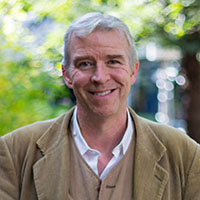Louis Beaufort Stewart (1861-1937), described fetchingly as an “educationist” in the 1912 book Canadian Men and Women of the Time, left his greatest monument not in the classroom but in the observatory that bears his name on the St. George campus. A professor of surveying, geodesy and practical astronomy in the department of civil engineering, Stewart taught when Canada was young and its vast geography was being probed and measured and harnessed by engineers of all kinds. Stewart’s popularity with students, his energy, his professorial position and even his status as a war hero (he served in the 92nd Regiment during the Northwest Rebellion of 1885) made him an important figure at U of T and in the engineering profession.
In 1908, Stewart spearheaded the building of a U of T observatory that would support formal meteorological and astronomical studies. He took much of the masonry from the old Toronto Magnetic and Meteorological Observatory, located on King’s College Road and demolished in 1907. The new observatory, hard by University College, was vital to U of T’s astronomical pursuits. For more than 40 years – until 1953 – it laid the groundwork for U of T’s increasing expertise in exploration of the heavens. This endeavour would have its grandest moment yet in Ian Shelton’s 1987 discovery of a new star – a supernova – in a neighbouring galaxy. He discovered it at the university’s former Southern Observatory in Las Campanas, Chile. But with the opening of U of T’s larger David Dunlap Observatory in Richmond Hill during the 1930s, the observatory’s days came gradually to an end, and it found itself with new occupants. Out went the spiritual sons and daughters of Galileo and in came their earthbound cousins, the Students’ Administrative Council (SAC).
Today, the observatory’s original hardware is a distant memory. The dome through which the vault of the heavens was viewed is sealed, the telescope long gone. But the building betrays its characteristics in other ways: a rabbit’s warren of rooms; the thick stone lightened by a century-and-a-half’s worth of sun; the windowed tower, topped by the dome; and the clock room in the basement, which provides a nod to the measurement of time and where some of U of T’s big public clocks are controlled.
Externally, the building has maintained its original integrity. The only alteration of note is a memorial on its back wall. Here, in a tableau of a twisted bicycle, tank treads and abandoned shoes, the Chinese democracy movement and the 1989 student deaths in Tiananmen Square are memorialized. A students’ memorial on a students’ building, which was built to inspire big dreams. Perhaps the Stewart Observatory remains a place to gaze upon the stars after all.
Brad Faught (PhD 1996) is a Toronto-based freelance writer and historian.
Recent Posts
For Greener Buildings, We Need to Rethink How We Construct Them
To meet its pledge to be carbon neutral by 2050, Canada needs to cut emissions from the construction industry. Architecture prof Kelly Doran has ideas
U of T’s 197th Birthday Quiz
Test your knowledge of all things U of T in honour of the university’s 197th anniversary on March 15!
Are Cold Plunges Good for You?
Research suggests they are, in three ways





